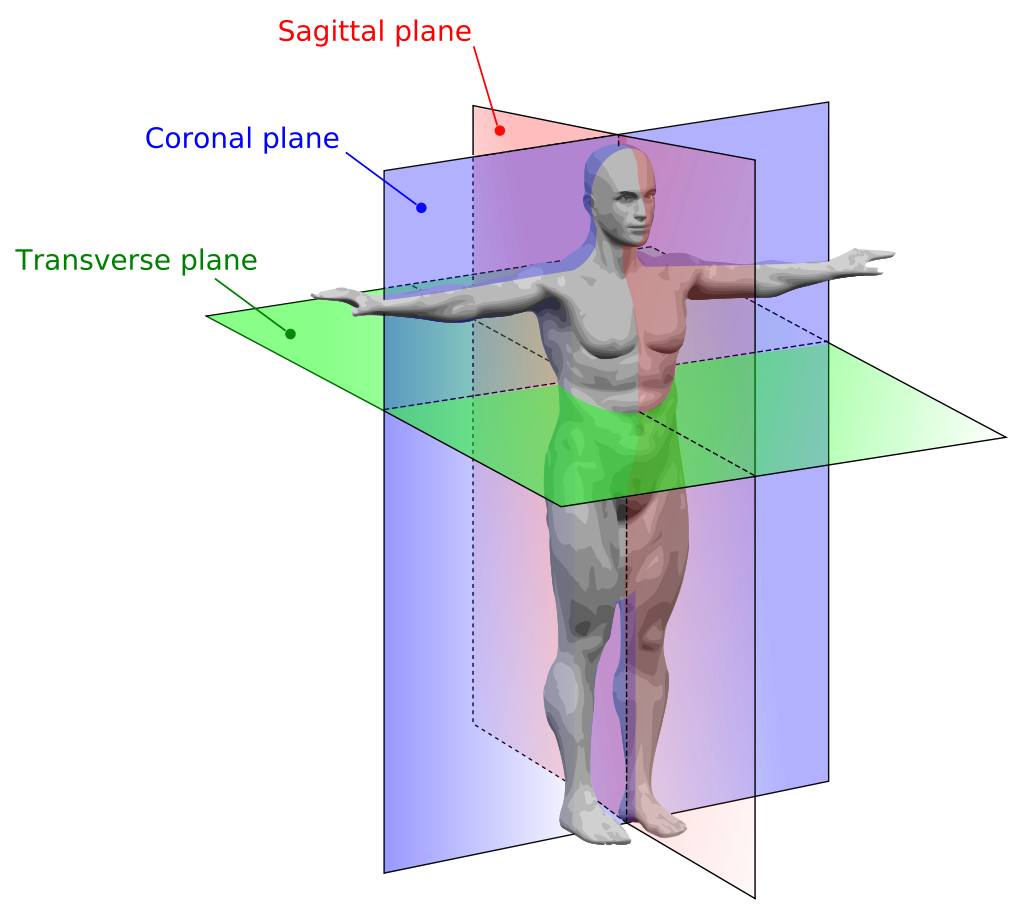To better identify the locations of the organs that contribute to vital functions, you need some points of reference for description. To serve that function, we will now define different planes of the body. These imaginary flat surfaces run through the body in different directions. They are used by medical professionals to examine various internal body parts. Directional orientation is another anatomical tool used to describe how parts of the body are related to one another.
Each organ system spans large regions of the human body. It is helpful, therefore, to establish reference planes and directions that can help us describe specific locations of structures as we discuss them. To make sure everyone is talking about the same thing, anatomists and physiologists often refer to anatomical position and the body planes that penetrate it. Anatomical position describes a person standing upright, with the arms at the sides and the palms facing forward (as demonstrated in the image below). Body planes (a plane is a flat, two-dimensional surface) are imaginary surfaces that run through the body and divide it into different sections. We can talk about a specific location using the planes as reference points within the anatomical position.

Figure 1. Sagittal, Coronal, and Transverse body planes and their intersections. By YassineMrabet (Human Anatomy Planes)/Wikimedia Commons/CC-BY-SA.
There are an infinite number of planes running through the human body in all directions. However, we will focus on the three planes that are traditionally used when discussing human anatomy (see Figure 1). First is the transverse plane, (also called the horizontal plane), which divides the body into top and bottom. In anatomical position, transverse planes are parallel to the ground. The second is the coronal plane, which is a vertical plane that divides the body into the front and back sections. If you do a “belly flop” into the water, you sink into the water via the coronal planes. Finally, we will refer to the sagittal plane, which divides the body into left and right sections with a vertical plane that passes from the front to the rear.
You can use other terms to further pinpoint an anatomical location. These terms are used to describe a location in relation to other structures. Some of them may be terms you have heard in everyday conversation; a lateral pass in football, for example, is a pass toward the sideline.
Superior, Inferior, Anterior and Posterior
The first set of directions that we will explore are superior, inferior, anterior, and posterior.
In humans, which stand upright on two feet, there are other terms that are synonymous with these four terms. Cephalic means toward the head and is the same as superior for a human in anatomical position. Caudal means toward the tail, or same as inferior for a human in anatomical position. Dorsal means toward the back and ventral means toward the belly; so dorsal and posterior are the same direction and ventral and anterior are the same direction for a human in anatomical position. This would not be true for a four-legged animal, such as a rat or cat you might dissect in lab.
Medial and Lateral
Next are the terms that relate structures to the midline. These are medial, lateral, and intermediate.
Proximal, Distal, Superficial, Deep
These next terms are used when referring to either appendicular parts of the body (arms and legs) or position in body relative to the external surface. These are proximal, distal, superficial, and deep.
Directions and Orientation
Table 1 lists all of the human anatomical directions that we discussed.
| Table 1. Anatomical Directions and Orientation | |
|---|---|
| Directional Term | Meaning |
| superior | above (or toward the head) |
| inferior | below (or toward the feet) |
| distal | farther from the trunk or origin |
| proximal | closer to the trunk or origin |
| deep (internal) | away from the surface |
| anterior (ventral) | toward the front (or toward the belly) |
| posterior (dorsal) | toward the rear (or toward the back) |
| medial | toward the midline |
| lateral | toward the side |
LECTURE: Anatomical Toolbox
Watch these lectures from Wendy Riggs to learn more about Directional Terminology and Planes of Section.
Candela Citations
- Unit 2, Module 2. Authored by: Open Learning Initiative. Provided by: Carnegie Mellon University. Located at: https://oli.cmu.edu/jcourse/workbook/activity/page?context=43488b3780020ca6001fbd3663aaf2d7. Project: Anatomy & Physiology. License: CC BY-NC-SA: Attribution-NonCommercial-ShareAlike
- Directional Terminology. Authored by: Wendy Riggs. Provided by: College of the Redwoods. Located at: https://youtu.be/nS9wLceQKco. License: CC BY: Attribution
- Planes of Section. Authored by: Wendy Riggs. Provided by: College of the Redwoods. Located at: https://youtu.be/ks5HOnk6K3E. License: CC BY: Attribution